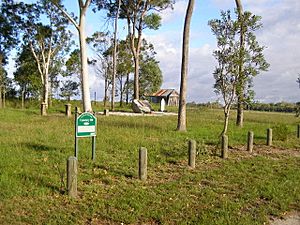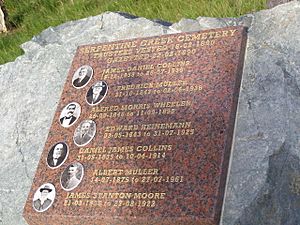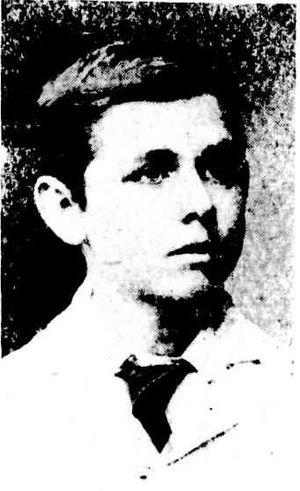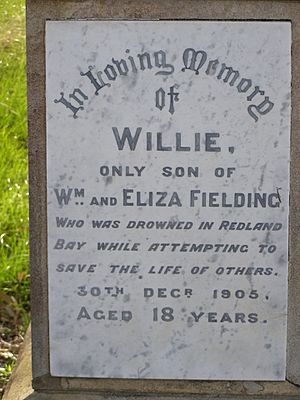Serpentine Creek Road Cemetery facts for kids
Quick facts for kids Serpentine Creek Road Cemetery |
|
|---|---|

Serpentine Creek Road cemetery, Redland Bay, 2006
|
|
| Location | 398-408 Serpentine Creek Road, Redland Bay, City of Redland, Queensland, Australia |
| Design period | 1870s–1890s (late 19th century) |
| Built | 1890–1945 |
| Official name: Serpentine Creek Road Cemetery, Redland Bay Cemetery, South Redland Bay Cemetery | |
| Type | state heritage (built) |
| Designated | 6 January 1999 |
| Reference no. | 601927 |
| Significant period | 1890s-1945 (fabric and historical use) |
| Significant components | fence/wall – perimeter, trees – remnant scrub, grave surrounds/railings, burial/grave, memorial/monument, headstone |
| Lua error in Module:Location_map at line 420: attempt to index field 'wikibase' (a nil value). | |
The Serpentine Creek Road Cemetery is a special old cemetery located at 398-408 Serpentine Creek Road in Redland Bay, Queensland, Australia. It was first opened in 1890 and was used until about 1945. This cemetery is also known as Redland Bay Cemetery or South Redland Bay Cemetery. It is considered an important historical site and was added to the Queensland Heritage Register on January 6, 1999.
Contents
History of the Serpentine Creek Road Cemetery
The Serpentine Creek Road Cemetery began in 1890. It was created to serve the farming families living in Redland Bay and nearby areas like Mount Cotton and Gramzow (which is now called Carbrook). The cemetery stopped being used for burials around 1945. Today, it is still a protected cemetery area. The Redland City Council now looks after it.
Why Was the Cemetery Needed?
In the 1860s, people started settling in the Redland Bay area. They came to farm crops like cotton, coffee, and sugar. There was also a lot of valuable timber, like cedar, being cut down. By the 1880s, Redland Bay became known for growing fruits such as bananas, oranges, and pineapples.
As more families moved to the area, they needed local services. A state school opened in 1886, and a community hall (School of Arts) was built in 1889. People lived in nice wooden houses with flower gardens.
There was an existing cemetery nearby at Mount Cotton, but it was for the German Lutheran community. It was also quite a distance away on rough roads. The growing community of Redland Bay needed its own public cemetery for everyone.
How the Cemetery Was Established
In September 1889, the local council, called the Tingalpa Divisional Board, asked the government for land for a cemetery. They wanted about 20 acres. In February 1890, 5 acres of this land were officially set aside for the cemetery.
In May 1890, five local farmers were chosen to be the first trustees. These trustees were like a committee that managed the cemetery. Their names were Frederick Muller, James Collins, Edward Heinemann, James Moore, and Daniel James Collins. Some of these men were also involved in the local council and school committees.
The chosen land was on the road between Redland Bay and Gramzow. This road is now called Serpentine Creek Road. The area was covered with trees like gum, casuarina, and bloodwood. It is not known how much of the land was cleared for graves.
The Cemetery's Later Years
For about 18 years, the Redland Bay Cemetery on Serpentine Creek Road was the only public cemetery in the area. However, by the early 1900s, some people felt it was too far away and lonely.
In 1907, a local council member offered to donate land closer to Redland Bay for a new cemetery. This new cemetery, located on Gordon Street, opened in 1908. To avoid confusion, the new one was called the North Redland Cemetery. The original cemetery on Serpentine Creek Road became known as the South Redland Bay Cemetery by 1925.
Only a few burials were moved from the old cemetery to the new one. Both cemeteries continued to be used for some time. The Serpentine Creek Road Cemetery officially closed around 1945.
In 1977, the Redland Shire Council took over control of the cemetery reserve. This happened after people asked for the site to be protected.
Recent Efforts to Preserve the Cemetery
In 1995, the old cemetery was recognized as an important local and regional site. The local community, with help from the Redland Shire Council, has been working to clear the grounds. They are also trying to find grave sites and record information from the headstones that are still there. After a fire in 1997, many native trees have grown back.
What You Can See at Serpentine Creek Road Cemetery
The Serpentine Creek Road Cemetery is a 5-acre (2.023 hectare) area. It is on the eastern side of Serpentine Creek Road. The cemetery sits on a small hill, making it easy to see from a distance. It is surrounded by farms.
Graves and Memorials
About a dozen graves have been found in the southwest part of the cemetery, near the road. This area has been cleared, leaving native trees and grasses. The rest of the land is open woodland with trees like casuarina and wattle.
The graves are all facing east and are arranged in rows. Some headstones are still standing, with dates from 1896 to 1909. Many of the headstones and grave surrounds (like fences around the grave) have been damaged over time.
One of the most noticeable memorials is for Willie Fielding. It is a tall sandstone monument with a marble plaque. The plaque says he was the "only son of Wm and Eliza Fielding" and that he "was drowned in Redland Bay while attempting to save the life of others 30th Dec 1905 aged 18 years." Willie Fielding died trying to save others in a boating accident. His funeral was very well attended.
Plants and Trees
The cemetery land has been disturbed by fires and grazing animals over the years. However, it still has a good mix of native plants, including some that are rare. The types of plants here are similar to those found in the nearby Serpentine Creek Conservation Park. This makes the cemetery important for protecting the local plant life.
There is a wire fence along the front of the cemetery, but no fence around the graves themselves. Some burnt parts of an old fence can still be seen in the middle of the reserve. These fences were likely used when the land was used for grazing animals.
Why Serpentine Creek Road Cemetery Is Important
The Serpentine Creek Road Cemetery was added to the Queensland Heritage Register on January 6, 1999, because it meets several important criteria.
Showing Queensland's History
This cemetery, started in 1890, helps us understand how the Redland Bay area grew in the late 1800s. It shows how early farming communities worked to create local facilities. The small cemetery, located on a hill among farms, gives us a clear picture of life back then.
Rare and Special Features
The cemetery is also important because it has a rare mix of native plants. Much of the original vegetation in Redland Bay has been lost due to farming and new buildings. This makes the cemetery a special place for preserving the local environment.
Beautiful and Rustic Look
The cemetery has a unique beauty. It stands out on the skyline and has a rustic feel with its few remaining grave sites. These sites include old headstones, memorials, and grave surrounds made of concrete and iron.
Connection to the Community
This place is very important to many families in the Redland Bay area. It is connected to their family histories and the early days of their community. It holds special meaning for social, cultural, and spiritual reasons.




